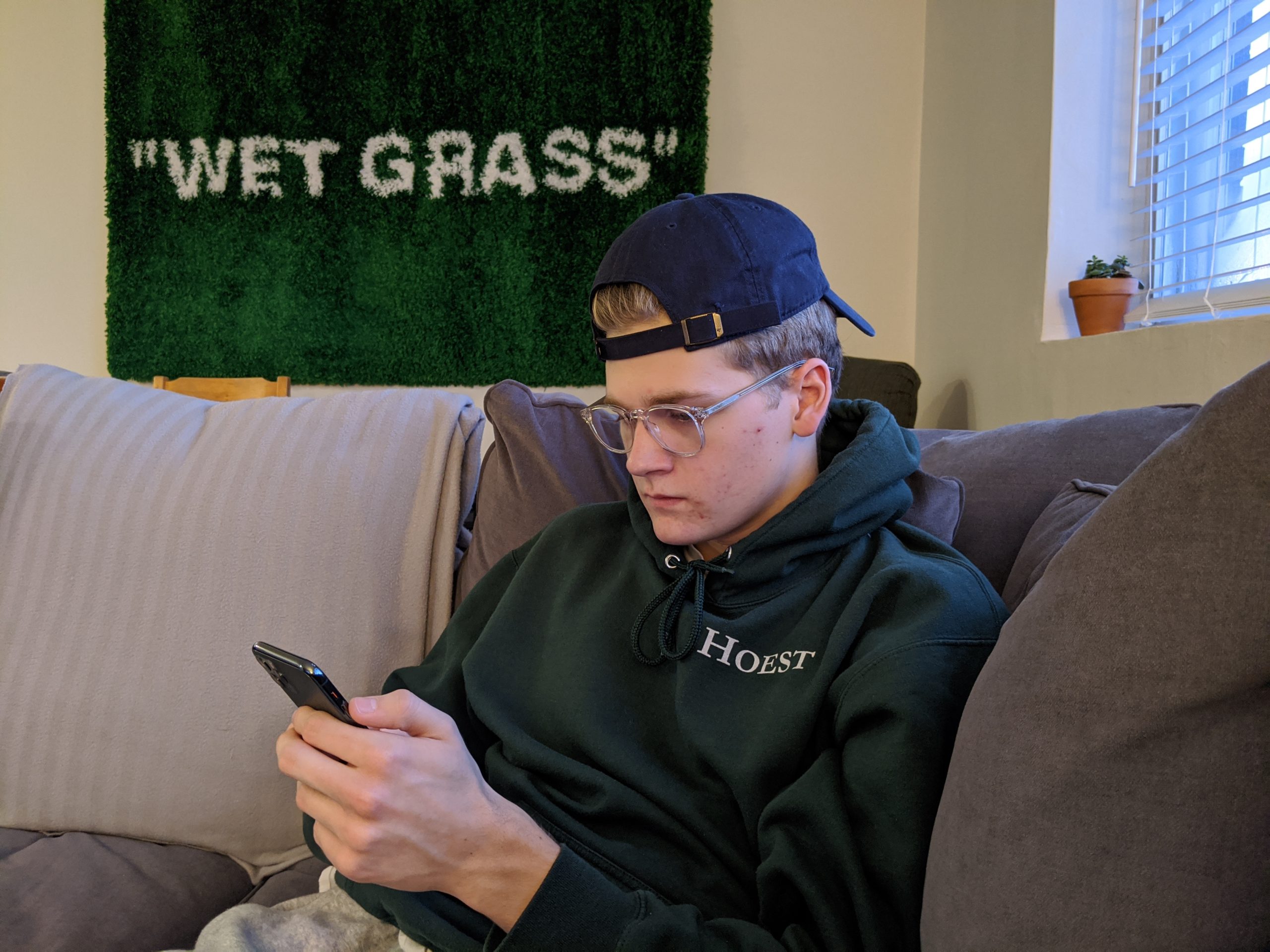Many teenagers use social media as an escape from their everyday life, but for one business-savvy teen, his Instagram account is paying the bills.
At just 19 years old, Ryan Carter is contemplating whether he should buy a Tesla or invest in real estate—all thanks to his dank memes.
Carter runs the Instagram account @hoest, a meme page with 1.6 million followers as of January 2020, whose brand is worth three-quarters of a million dollars.
While suffering a concussion from playing hockey, Carter, then 15, created the account out of boredom.
“I wasn’t allowed to do anything, so I got really bored and so obviously I went on my phone which I wasn’t supposed to do,” Carter said.
“I went to the [Instagram] explore page and noticed there was an account that just posted memes, and they had like 11K at the time, and they had the ‘K’ beside their follower account,” Carter added. “And, I thought that was the coolest thing ever, so I made my own account.”
Originally motivated by curiosity, Carter said he began posting memes on Instagram just to gain followers, without really considering the business potential.
“I knew you could make money, but I thought only big influencers like Gigi Hadid and the models and stuff made money,” Carter said. “I didn’t realize that as a meme page you could make money, so I just wanted the ‘K’ beside the follower count.”
In his quest to gain more followers, Carter tried cracking the Instagram algorithm which makes posts appear on the explore page—a tab of the app where Instagram users can see viral posts from accounts, even if they don’t follow them.
“I would ‘like’ people’s content, I would use hashtags trying to grow, I got to 750 followers and then someone DMed [direct messaged] me asking me for ‘like for like,’ which at the time was how you got onto the explore page to gain followers,” Carter explained.
“Once you got onto the explore page, even though I only had 750 followers, I realized my videos could get six million views in 24 hours,” Carter said. “With those six million views you probably gain 10 to 15 thousand followers, and so I got to 250K in four months from zero.”
The work behind the memes
Waking up at exactly 9:30 a.m. every day, Carter said the first thing he does is check on his account, and then he has just 15 minutes to reply to his most important Instagram messages from clients–big companies such as Ubisoft, Bud Light, Fashion Nova, and Ten Tree–before he posts his first post of the day at 9:45 a.m. After his first post, he moves to his emails where he once again responds to clients.
“It’s pretty insane the brand itself is like $750,000 because I’m verified on TikTok and I’m growing Facebook, YouTube and a few other things,”
Ryan Carter, professional Instagram memer
Because he gets anywhere from 2,000 to 7,000 follower requests overnight, and the same if not more during the day, he has installed a program which automatically accepts the follow requests in just minutes, compared to the hours it would take by hand, he said.
Carter keeps posting throughout the day, on average publishing posts 20 to 50 times daily, until about 2 a.m.
“3 a.m. is usually when I go to bed, and then I wake up at 9:30 a.m. and do it all again the next day,” he said of his tightly managed schedule.
Instagram influencers need high follower counts and activity engagement because companies pay them money to post advertisements for a certain period of time-based on account popularity, Carter said.
“Basically Instagram accounts, the value of them is based on how much you can make in like a three to five-year time frame,” he explained. “Right now, I got offered from Barstool Sports a contract, so not just some BS offer, for $400,000 US, which is about $531,000 Canadian.”
Carter, whose only other job was a part-time position at Foodland when he was 16, said he declined the offer to buy his account because he wants to continue working for himself.
“Right now, I’ll probably make 150 to 250K in the next 365 days on Instagram just from ad revenue,” Carter said.
Carter explained he gets his income from posting Instagram advertisements for companies, which range in price from $200 to $3,000 for a 24-hour posted advertisement.
He said he posts anywhere from one advertisement a day to going a week without posting one, depending on how much he is approached by companies. He compared the experience to a salesperson who works on commission.
“Some months you make no money, and some months you make like $20,000,” he said. “So you kind of have to have a backup which is what I do. I have enough money saved up to pay all my bills for a year straight. So say Instagram does die, I have a year to just live and not be in complete panic mode to get a job, or find a job, or panicking trying to get the account back.”
Managing money
“Influencers, it’s a trend that’s on the rise,” Simon said. “There’s hundreds of thousands of different accounts that are making money and you don’t really need millions of people today to make that much money.”
However, brands realizing the advertising potential of social media is a phenomenon Simon said has only started in the past two or three years, despite the risk being so small.

“As much as the influencer is making money, it’s still super cheap for these brands to experiment,” he said. “For the brand to spend this type of money, I mean they’ve got tons of cash, so to run an experiment, it’s little risk.”
Carter said coming into all of this money at a young age feels unbelievable. He added that it feels unreal because he still lives like a student.
“It’s pretty insane the brand itself is like $750,000 because I’m verified on TikTok and I’m growing Facebook, YouTube and a few other things,” he said. “It’s weird because I don’t have boatloads of money, I just sit at home and work on my phone all day.”
Although Carter expressed a “fear of spending money,” which sometimes makes him think about whether he should buy a $150 sweater for a year before making his decision, he does want to spend his money on unique things.
“I do want a Tesla, I’ll probably get a model three next year,” he said. “I also do want to get a couple houses or rental properties just for investment, and I like art so I bought some art and that’s about it.”
Speaking of his two designer Ikea rugs which hang from his apartment walls, Carter added that he likes to buy limited items.
“I like things that are different and cool and that not many people have,” Carter said. “I woke up at like 5 a.m. to go to Ikea and sit out there for six hours just to get them.”
Sacrifices
Despite being grateful for the opportunities his meme account has provided, Carter also spoke about the sacrifices he’s had to make. For instance, he said he has had to live without a social life due to working a lot.
“I’ve definitely had to do some rearranging of priorities there for sure,” he said.
Beyond missing out socially, Carter said managing the account has also taken a physical toll on him.
“I have had like three or four concussions [from hockey] and so I’m not really supposed to be on my phone really at all,” Carter said. “When you spend like 15 hours a day on your phone, … it’s really tough, and I definitely have like arthritis in my hand from holding my phone all day—like early onset arthritis.”
To combat some of the negative physical effects, Carter said he recently bought special glasses that dim screens’ blue light to minimize headaches and eye strain from looking at a phone.
“You have to adapt to social media platforms that come up like right away so you don’t miss the train to get a front row seat,” Ryan Carter
Having the account has also caused Carter to change how he plans his days because being without WiFigives him anxiety, he said.
The most recent sacrifice Carter had to make was the decision to drop out of Carleton University earlier this year, where he was in his second year of international business studies, in order to pursue Instagram full time.
“I just like to work and see results, it’s just my mindset like I love working, so I was already thinking of dropping out,” Carter said. “I can always go back to school, but Instagram won’t be around forever.”
“You have to adapt to social media platforms that come up like right away so you don’t miss the train to get a front row seat,” he added.
Don Wood, Carter’s business teacher throughout all four years of high school, said although Carter always showed promise in business, he also worked harder than anyone else.
“What I would say about Ryan that separated him from the others–like he’s inquisitive, he’s bright, he asks a lot of great questions–but it’s the work ethic,” he said.
“I showed my accounting class a report he did and like, it’s a book,” Wood joked. “He would colourize the type and the attention to detail was just amazing for sure, and I mean there’s no substitute for great work ethic in any career.”
What’s next?
Carter said he is looking to hire an assistant to help him achieve his goal of becoming the next big multi-platform social media brand. And if that doesn’t work out, he said he has marketing job offers from Toronto and New York to fall back on.
Carter’s advice to anyone looking to start a business is to be ready to put in the work required.
“I would say the key is building a brand before building your bank account, brand is key and also consistency is key,” he said. “The lowest [amount of posts] I’ve ever done in four years was six posts in a day.”
Carter added it’s important not to forget why you started pursuing your passion in the first place.
“Be consistent and work hard and don’t chase it for the money,” Carter added. “The money is a huge bonus, obviously, but do it because you want to do it.”
Featured image by Jillian Piper.






